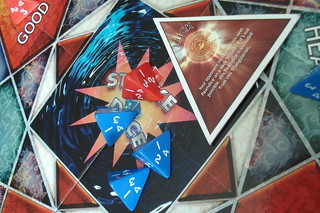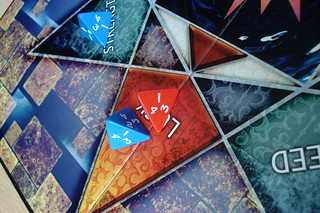| Strategy | Luck |
|---|---|
| Interaction | Components & Design |
| Complexity | Score |
Our copy of Strike Dice has kindly been supplied by the publisher, Mage Company. Thanks a lot.
Strike Dice is a game that wants to tell a story. There is a horde of monsters on the box, opposed to the player stand-in whose hand is visible holding a dice. When you unfold the board it shows a sort of compass, with the cardinal directions pointing towards Good, Evil, Luck and Intellect. It’s all very high fantasy.The four minor directions point to Speed, Strength, Sight and Hearing which is much less dramatic already and doesn’t ask as many deep and philosophical questions, but they have to point somewhere. Unfortunately, as much as Strike Dice wants to tell a story, it doesn’t. The names of the eight directions have less impact than the alignments on a 4th Edition Dungeons and Dragons game and the monsters are just there, as well. There isn’t even a bit of flavour text in the manual to explain why monsters, why Speed is closer to Evil than Strength and why everything is about triangles.
Flavour text is not the only thing the manual doesn’t give you: in our version of it, an idea how to play the game is also on that list. I don’t want to bash the manual much, there is an updated version of it now that you can play the game from. But with ours, I was glad the authors are nice guys and were happy to help us along.With their help, we learned how to play and it goes like this: each player has eight pawndice – some people may be familiar with them as a d4 – and the goal in each triangulation – vulgo: rounds – is to have as many of them on the board as possible. The easiest way to play Strike Dice is in two players, so that’s what we’ll stick with for now. The first player rolls one pawndice on his first roll and places it on the board. After that, every turn consists of rolling two dice and placing them. When you have no dice on the board then you have to place it on one of the red compass points – the cardinal directions, coincidentally called tribases – because you can only enter the board there. Subsequent dice enter the board through any of the red tribases you’re holding and move from there to another one of either colour. The movement point your pawndie has are given by the sum of the numbers on the bottom of the dice, making higher numbers slower thanks to the properties of the common d4. A simple yet effective mechanic to meet that goal.
Counting where you can actually go with that is less simple as you’re counting a bunch of triangles, some of which touch at the sides while others only touch at the points, yet still only cost one point of movement. The new manual has a diagram that explains this, but we were not so lucky. Either way, it’s needlessly complicated, the truth about movement is much simpler. You may only end your move on another tribase, not on any of the other triangles in between, and you may only start your move on a red tribase that you already occupy with a pawndie. Strictly speaking, you never move at all, you just add more dice to the board. Anyway, starting from a red tribase, rolling a four means you can only go to the two adjacent dark tribases – not a big issue because fours may never be on red ones, anyway. Twos and threes can go there as well, but also to the two red tribases at right angles to your start base. And only ones can go to the dark tribases beyond those, meaning anywhere but the opposite red base. Trust me, this way is easier than counting.

Your dice can occupy the same tribases as your opponent’s without interfering with each other, regardless which number they show – the so-called power of the dice. Violence breaks out only between opposing dice on opposite tribases. Thematically, I can see the point in these: when you hold the power of Evil, I don’t usually defeat you by being more Evil than you. Being more Good than you are Evil, that’s the ticket. Playing the game, this rule means you’ll be looking around for a bit before you figure out where your dice can go. In terms of gameplay, I don’t see where the difference is between this approach and letting dice on the same tribase fight, that would be easier to keep an overview. What happens between dice on opposite tribases? The weaker one has to leave and returns to its owner. In case of a tie, both may stay. You are not allowed to place a die in a position where it would immediately be defeated. If you don’t have any other options, or cannot place the die you rolled for other reasons, then that die is excluded from the current triangulation. That’s how a winner is decided as well, when all dice are either on the board or excluded, then the player with fewer excluded dice wins the round and gains one tricard. You may be spotting a pattern here, tricards are triangular cards. Each belongs to one tribase and has a special effect that you can use once on each subsequent triangulation, provided you occupy that tribase. The effects vary widely in usefulness and thematicality. Intellect, for instance, grants you a sort of mind control: you may decide where to place the opponent’s next die. Somewhat thematic, but much less useful than it sounds. Speed, on the other hand, lets you roll all your dice and place them at once. Quite thematic and sometimes useful. You keep triangulating until all tricards have been awarded, then whoever holds more wins the game.
Strike Dice in two players is not a bad game, but it is, at least to me, bland and too long for what it does: rolling dice and placing them on triangles, then taking them back when the other player rolls higher, just to receive a card and then do the same again. Does get old after two rounds. Furthermore, there is less strategy involved then I thought at first – we figured out quickly that the higher roller wins, there’s nothing you can do about that. And if both players roll the same, the game will end in a tie, not in a triumph of superior planning.

In three players, not much changes about the game except that you may drive off two opponents’ pawndice at once, when you roll well enough. In four players, the experience is more of a double-edged sword. The way to play in four players is as two teams of two. Powers are now only compared and dice removed when two dice from one team stand opposite two dice of the other team. As long as one dice is missing, nothing happens. This does open the doors for more interesting strategy: do you place your low die next to your partners low die in order to see them defeated and get them back to be rerolled? Or do you put a higher die there hoping you can hold the base? Unfortunately, this also makes the game last even longer.
Strike Dice wanted to tell a story, but unfortunately didn’t. Strike Dice also wanted to be a strategic dice game, you may want to form your own opinion on that. Strike Dice is a game with interesting ideas – using dice to occupy bases, making them move faster the weaker they are, do all that with only triangles – but it feels to much like the game was just made to fit those ideas, with too little thought given to how it would play and how it would keep players interested.








